Nutritional deficiencies of Custard Apple
Nutritional deficiencies of Custard Apple
Iron
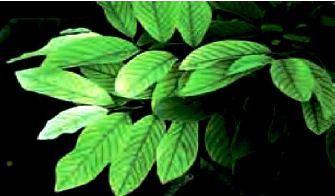 Cause: Insufficient iron available to the tree. Generally caused by poor root health or over-liming.
Cause: Insufficient iron available to the tree. Generally caused by poor root health or over-liming.- Identification notes: Causes an overall yellowing or whitening of leaves with the veins remaining green.
- Treatment: Apply a foliar spray of iron chelate or soluble ferrous sulphate.
- Prevention: Do annual leaf and soil analyses to monitor nutrient levels. To avoid over-liming, calculate lime or dolomite rates carefully in accordance with soil analysis results. Mulch trees to improve root health.
Sulphur
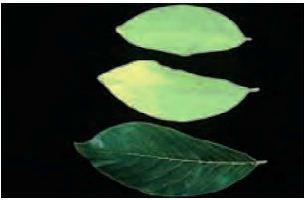 Cause: Insufficient sulphur available to the tree.
Cause: Insufficient sulphur available to the tree.- Identification notes: Healthy leaf (bottom) for comparison. Causes a uniform yellowing of the leaves but the veins do not remain green. Rarely seen in well-managed orchards.
- Treatment: Not serious enough to warrant treatment.
- Prevention: Do annual leaf and soil analyses to monitor nutrient levels. Where deficient, use fertilisers with higher sulphur content.
Manganese
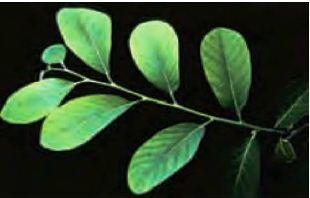 Cause: Insufficient manganese available to the tree. Generally caused by high soil pH or high levels of soil phosphorus or zinc.
Cause: Insufficient manganese available to the tree. Generally caused by high soil pH or high levels of soil phosphorus or zinc.- Identification notes: Affected leaves are a mottled pale-green, with green veins. Yellowing is more pronounced towards the leaf tips. Rarely seen in well-managed orchards.
- Treatment: Apply foliar spray of manganese sulphate and urea.
- Prevention: Do annual leaf and soil analyses to monitor nutrient levels. Apply manganese to the soil when indicated by leaf and soil analysis results.
Magnesium
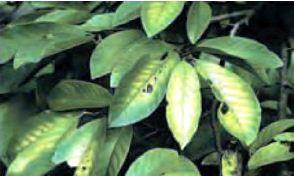 Cause: Insufficient magnesium available to the tree. Generally results from excessive use of potassium.
Cause: Insufficient magnesium available to the tree. Generally results from excessive use of potassium.- Identification notes: Yellowing occurs in bands on either side of the midrib while the margin of the leaf remains green. A reddish-brown discolouration sometimes develops in the yellow areas. Most common in acid sandy soils.
- Treatment: Do leaf and soil analyses to check soil pH and magnesium levels. Apply dolomite or magnesium oxide (choice depends on pH level). A short-term response can be achieved with a foliar spray of Epsom salts and urea.
- Prevention: Do annual leaf and soil analyses to monitor soil pH and nutrient levels. Apply magnesium to the ground under the trees according to leaf and soil analysis results. Do not apply excessive amounts of potassium fertiliser.
Nitrogen
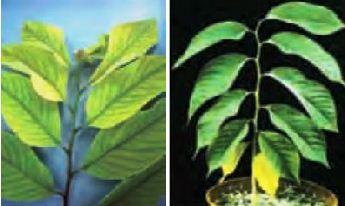 Cause: Insufficient nitrogen available to the tree.
Cause: Insufficient nitrogen available to the tree.- Identification notes: Left: mild symptom showing the pale green leaves. Right: severe symptom where the oldest leaves turn bright yellow and fall prematurely.
- Treatment: Do a leaf analysis to confirm the diagnosis. Adjust the fertiliser program according to the leaf analysis results.
- Prevention: Do annual leaf and soil analyses to monitor nutrient levels. Apply appropriate amounts of nitrogen fertiliser throughout the growing season.
Boron
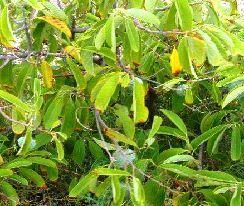 Cause: High uptake of boron from the soil. Generally caused by applying boron unevenly or at high rates.
Cause: High uptake of boron from the soil. Generally caused by applying boron unevenly or at high rates.- Identification notes: Leaves near growing point yellowed, growth bud appear white or brownish dead tissue.
- Treatment: Apply boron at 2.0 g/m2 and broadcast over the ground area under the canopy. Boron and calcium sprays during flowering and early fruit set are beneficial in reducing internal fruit browning.
- Prevention: Do annual leaf and soil analyses to monitor boron levels. Take particular care to apply boron at the correct rates.
Potassium
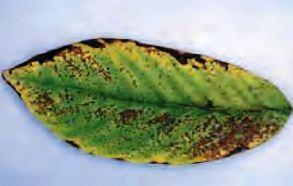 Cause: Insufficient potassium available to the tree. Generally caused by an imbalance of potassium, calcium and magnesium in the soil. More common in light soils where heavy leaching occurs and in trees with heavy crop loads.
Cause: Insufficient potassium available to the tree. Generally caused by an imbalance of potassium, calcium and magnesium in the soil. More common in light soils where heavy leaching occurs and in trees with heavy crop loads.- Identification notes: Yellowing begins at the margin of the leaf and spreads towards the veins. Small black spots develop within affected areas.
- Treatment: Do a leaf analysis to confirm the diagnosis. Adjust the fertiliser program according to the results.
- Prevention: Do annual leaf and soil analyses to monitor nutrient levels. Apply appropriate amounts of potassium fertilizer throughout the growing season.
Boron toxicity
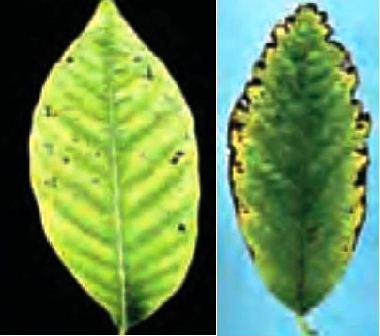 Cause: High uptake of boron from the soil. Generally caused by applying boron unevenly or at high rates.
Cause: High uptake of boron from the soil. Generally caused by applying boron unevenly or at high rates.- Identification notes: Note the small brown spots developing inside the burnt margin.
- Treatment: No applicable
- Prevention: Do annual leaf and soil analyses to monitor boron levels. Take particular care to apply boron at the correct rates. Apply boron evenly when spraying it on the ground or applying it by fertigation.
Manganese toxicity
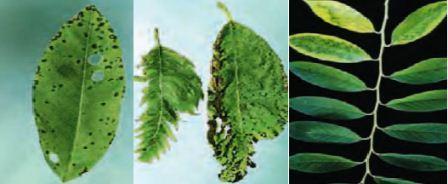 Cause: High uptake of manganese from the soil. Occurs in soils with high manganese levels when pH falls below 5.5 (1:5 water test).
Cause: High uptake of manganese from the soil. Occurs in soils with high manganese levels when pH falls below 5.5 (1:5 water test).- Identification notes: Affected leaves have an irregular yellow or whitish margin.
- Treatment: Do a leaf analysis to confirm the diagnosis. Apply lime or dolomite to raise soil pH to 6.5 (1:5 water test).
- Prevention: Do annual leaf and soil analyses to monitor nutrient levels. In high manganese soils, maintain soil pH at 6.5 or above (1:5 water test).
Zinc toxicity
 Cause: Insufficient zinc available to the tree. Generally caused by high soil pH or high levels of soil phosphorus.
Cause: Insufficient zinc available to the tree. Generally caused by high soil pH or high levels of soil phosphorus.- Identification notes: Affected leaves are yellow-green with green veins, smaller than usual, narrow and slightly distorted.
- Treatment: Apply zinc to the ground under the tree. In severe cases, also spray chelated zinc onto the spring flush.
- Prevention: Do annual leaf and soil analyses to monitor nutrient levels. Apply zinc to the ground under the trees annually according to leaf and soil analysis results.
Disorders
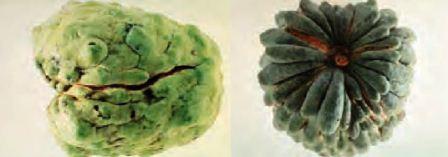

- Stone Fruits: Some fruits instead of attaining full size remain very small and become brown and dry up. These are known as stone fruits which are retained on tree for a long period. Competition among the developing fruits and high temperature are supposed to cause stone fruit formation.
- Fruit Cracking: This usually happens from a heavy rainfall or irrigation after a prolonged dry spell. Evenly distributed irrigation schedule and constant and uniform moisture level in the soil will reduce this Problem.
IPM for Custard Apple
To know the IPM practices for Custard Apple, click here.
Source: NIPHM, Directorate of Plant Protection, Quarantine & Storage
Last Modified : 6/4/2020
© C–DAC.All content appearing on the vikaspedia portal is through collaborative effort of vikaspedia and its partners.We encourage you to use and share the content in a respectful and fair manner. Please leave all source links intact and adhere to applicable copyright and intellectual property guidelines and laws.
RELATED ITEMS
Litchi production practices in Nagaland
This topic provides information about the cultivat...
Amla pests
This topics covers information about Amla pests.
Hemiplegia (Pakshaghata)
This topic provides information about Hemiplegia (...
Cucurbitaceous Vegetable Nutritional deficiencies
This topic covers information about Cucurbitaceous...
RELATED LANGUAGES
